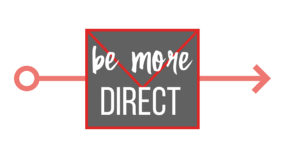First of all, what the heck is a “finished” story?
A finished story is a story where your beneficiary has already been helped. For example, say your organization helps homeless moms. For you, a finished story is where the mom has already been through your program, has moved out, and has a job that pays the bills, etc. If you’re a school or in the education space, a finished story is about the person who is already going to school or has graduated.
Are you with me? A finished story is where your organization has already done it’s work.
The Mistake Most Nonprofits Make
The mistake most nonprofits make is that every story they tell is a finished story.
That’s a guaranteed way to raise less money than you could be raising. Why? Because only telling finished stories has an unfortunate consequence: it diminishes the need in the mind of the donor. All donors hear about are people who have been helped, so they never emotionally feel the need your organization exists to serve, so they become less likely to give.
You can read more about this problem (and how to solve it) in our previous posts, “How to 8x Your Appeal Results” and “The Simple Outline For Appeals That Raise Money.”
So let’s talk about what you can do to raise more money and retain your donors longer . . .
When To Tell A Finished Story
This is the easy part. There are four main places and times to tell a finished” story:
- Your newsletter
- Your e-news update
- Your Annual Report
- During 1-to-1 Reports to major donors
There are, of course, other times. But those are the main times you should be sharing finished or “completed” stories with your donors.
How To Tell A Finished Story
In a nutshell, share the finished story and give the credit to your donor.
In our experience, most organizations don’t Report back to their donors often enough. And when they do, they barely mention the donor and they take all the credit. They say things like, “Last year we helped over 766 people …” or “We worked hard to save the Arts in Springfield over the summer and . . .”
We call that, “Ask, Thank, Brag” instead of the much more effective, “Ask, Thank, Report” formula.
Here’s the perspective you want: Report to your donors about what their gift accomplished. Not about what your organization did, but about what their gift did. You want to choose to look through the lens of the donor.
Here’s how to do it:
- Mention the donor early. Make sure she knows she’s part of the story! Have the first sentence of your newsletter be something like, “Thanks in part to your generosity, the Arts in Springfield were saved!”
- Give the credit to your donor. This is just an exercise in being other-centered. Look for places where you would say “Our [program name] served …” or “We provided $6 million worth of care …” Replace the mentions of your organization with a mention of the donor. You could say, “Thanks to your generosity, [program name] served …” and “You are part of providing $6 million worth of care.”
- Include the “before” and the “after.” Make sure your donor knows what the situation was like before your organization got involved. That will help your donor see just how big the transformation was — and how powerful her support is.
- Directly tell the donor that their gift helped provide the solution and caused the transformation, and highlight that sentence. Remember, your donors have busy lives and usually only look at fundraising pieces for a few seconds. Make sure it’s easy for her to see a headline or sentence that directly tells her she made a difference! Don’t hide that information — arguably the most powerful, important information the donor is hoping to hear — at the end of a long story in the last paragraph.
If you do these things you’re going to notice two incredibly powerful things happening . . .
First, your donor retention rate will increase (your donors will stick with you longer). That’s because donors will see how their gifts to your organization make a real difference. And when they see that their gifts make a difference, they are more likely to give you another gift.
Second, you’re going to start raising more money from your appeal letters. That’s because you’re going to have more donors to send them to (because you won’t be losing as many) and because donors trust you more! They see and feel that their gifts have made a difference, so they are more likely to give to you again!
So, go tell some finished stories in the right way at the right times. Then watch your organization raise more money!
Steven Screen is Co-Founder of The Better Fundraising Company and lead author of its blog. With over 30 years' fundraising experience, he gets energized by helping organizations understand how they can raise more money. He’s a second-generation fundraiser, a past winner of the Direct Mail Package of the Year, and data-driven.







